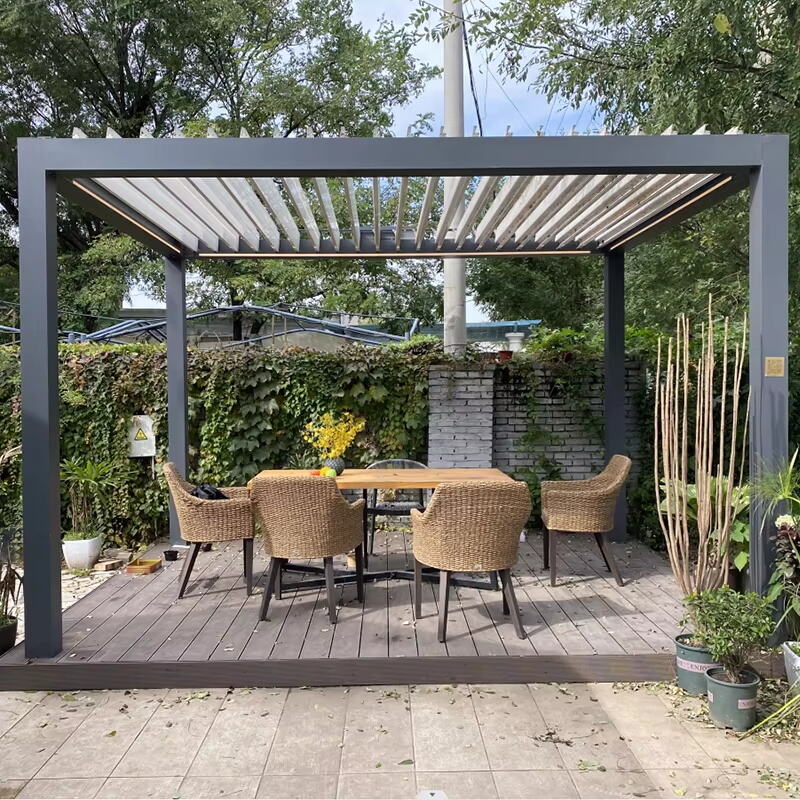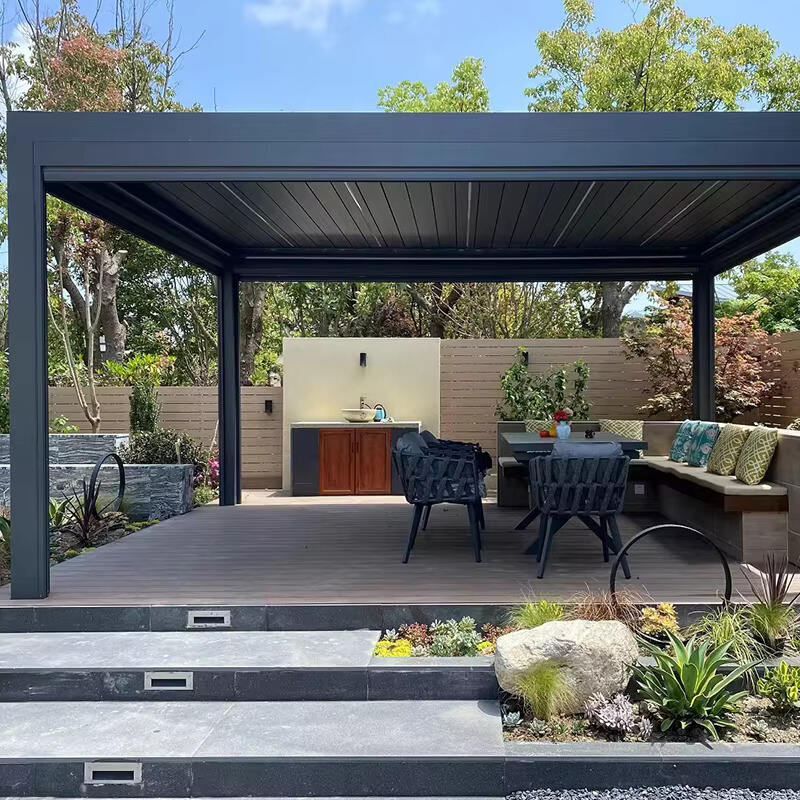กระแสความนิยมพื้นที่ใช้สอยกลางแจ้งอันหรูหรา
ปัจจุบันเจ้าของบ้านสมัยใหม่ต่างเปลี่ยนพื้นที่กลางแจ้งให้กลายเป็นส่วนต่อขยายอันทันสมัยของพื้นที่ใช้สอยภายในบ้าน โดยซุ้มระแนงได้กลายมาเป็นองค์ประกอบทางสถาปัตยกรรมอันสำคัญยิ่ง pergolas ได้กลายมาเป็นองค์ประกอบทางสถาปัตยกรรมอันสำคัญยิ่งที่ผสมผสานรูปแบบและหน้าที่เข้าด้วยกันอย่างลงตัว โครงสร้างอันงดงามเหล่านี้ไม่เพียงแต่ช่วยเสริมเสน่ห์ด้านทัศนียภาพให้กับภูมิทัศน์ใดๆ เท่านั้น แต่ยังสร้างพื้นที่ส่วนตัวสำหรับการพักผ่อนและการจัดกิจกรรมต่างๆ อีกด้วย
เสน่ห์ของเพอร์โกลาไม่ได้จำกัดอยู่แค่คุณค่าทางสุนทรียศาสตร์เท่านั้น แต่ยังสะท้อนถึงการผสมผสานอย่างลงตัวระหว่างภูมิปัญญาสถาปัตยกรรมแบบดั้งเดิมและแนวคิดการออกแบบร่วมสมัย ในปัจจุบันเจ้าของบ้านจำนวนมากต้องการเพิ่มศักยภาพของบ้านให้สูงสุด เพอร์โกลาจึงเป็นโซลูชันอเนกประสงค์ที่สามารถปรับให้เข้ากับไลฟ์สไตล์ที่หลากหลาย พร้อมเพิ่มมูลค่าให้กับบ้านได้อย่างลงตัว
ความหลากหลายในการออกแบบและความสวยงาม
ความกลมกลืนทางสถาปัตยกรรมกับทุกสไตล์บ้าน
หนึ่งในข้อได้เปรียบที่โดดเด่นที่สุดของเพอร์โกล่าคือความสามารถในการปรับตัวให้เข้ากับรูปแบบสถาปัตยกรรมที่แตกต่างกันได้อย่างยอดเยี่ยม ไม่ว่าบ้านของคุณจะมีดีไซน์แบบมินิมอลทันสมัย หรือเน้นเสน่ห์แบบดั้งเดิม เพอร์โกล่าสามารถออกแบบให้เข้ากับองค์ประกอบทางสถาปัตยกรรมที่มีอยู่ได้อย่างเหมาะสม เส้นสายที่เรียบง่ายและความงดงามเชิงโครงสร้างของสิ่งปลูกสร้างกลางแจ้งเหล่านี้ ช่วยสร้างการเปลี่ยนผ่านอย่างไร้รอยต่อระหว่างพื้นที่ภายในและภายนอกอาคาร
ตั้งแต่ดีไซน์ไม้คลาสสิกไปจนถึงโครงสร้างอลูมิเนียมที่ทันสมัย มี pergola ให้เลือกมากมายซึ่งสามารถปรับแต่งได้ไม่รู้จบ เจ้าของบ้านสามารถเลือกวัสดุ ผิวเคลือบ และองค์ประกอบการออกแบบต่างๆ เพื่อสร้างโครงสร้างที่สะท้อนสไตล์ส่วนตัวได้อย่างลงตัว พร้อมยกระดับความงามโดยรวมของบ้าน
ตัวเลือกการปรับแต่งและวัสดุ
Pergola แบบทันสมัยมีให้เลือกหลากหลายชนิดของวัสดุ แต่ละชนิดมีข้อดีและคุณลักษณะด้านดีไซน์ที่แตกต่างกัน โครง pergola ไม้แบบดั้งเดิมให้ความรู้สึกอบอุ่นเป็นธรรมชาติ และสามารถลงสีหรือทาสีเพื่อให้เข้ากับชุดสีใดๆ ก็ได้ ขณะที่ตัวเลือกอลูมิเนียมและไวนิลให้ความทนทานและการดูแลรักษาน้อยมาก โดยยังคงรักษารูปลักษณ์ที่หรูหราไว้ได้
ความเป็นไปได้ในการปรับแต่งยังขยายไปถึงขนาด ความสูง และรายละเอียดทางสถาปัตยกรรม ทั้งการตัดปลายแบบตกแต่ง ลวดลายตะแกรง และระบบไฟส่องสว่างในตัว ทำให้เจ้าของบ้านสามารถสร้างพื้นที่กลางแจ้งที่แท้จริงและไม่เหมือนใคร กลายเป็นจุดเด่นที่น่าพูดคุยและเป็นศูนย์กลางของภูมิทัศน์

ประโยชน์เชิงหน้าที่ที่มากกว่าความสวยงาม
ระบบควบคุมอุณหภูมิและความสะดวกสบาย
เพอร์โกล่าโดดเด่นในการให้ร่มเงาที่สามารถปรับเปลี่ยนได้สำหรับพื้นที่กลางแจ้ง ในช่วงฤดูร้อนที่อากาศร้อนจัด โครงสร้างเหล่านี้ช่วยลดความร้อนจากแสงแดดได้อย่างมีประสิทธิภาพ ขณะเดียวกันก็ยังคงการระบายอากาศและไม่ทำให้พื้นที่รู้สึกอึดอัด โดยการติดตั้งหลังคาแบบพับเก็บได้ หรือปลูกพืชเลื้อยคลุม ทำให้เจ้าของบ้านสามารถปรับระดับความร่มเงาได้ตามความต้องการและฤดูกาลที่เปลี่ยนแปลงไป
การติดตั้งเพอร์โกล่าอย่างมีกลยุทธ์ยังช่วยควบคุมอุณหภูมิรอบๆ ตัวบ้านได้อีกด้วย เมื่อติดตั้งใกล้หน้าต่างหรือประตูกระจก จะช่วยลดความร้อนจากแสงแดดที่เข้าสู่ตัวบ้าน ซึ่งอาจส่งผลให้ค่าใช้จ่ายในการทำความเย็นลดลงในช่วงฤดูร้อน
การเสริมสร้างพื้นที่ใช้ชีวิตกลางแจ้ง
พลูดานสมัยใหม่ทำหน้าที่เป็นตัวแบ่งพื้นที่กลางแจ้ง สร้างโซนที่ชัดเจนสำหรับกิจกรรมต่างๆ ภายในภูมิทัศน์ สามารถใช้กำหนดพื้นที่รับประทานอาหาร ครัวกลางแจ้ง หรือมุมอ่านหนังสือที่เงียบสงบ การจัดระเบียบเชิงพื้นที่นี้ช่วยให้เจ้าของบ้านสามารถใช้ประโยชน์จากพื้นที่อยู่อาศัยภายนอกได้สูงสุด ในขณะที่ยังคงรักษารูปแบบการออกแบบที่กลมกลืนกันทั่วทั้งทรัพย์สิน
ความหลากหลายของพลูดานยังขยายไปถึงบทบาทในการรองรับระบบความบันเทิงกลางแจ้ง อุปกรณ์ไฟฟ้า และแม้แต่พัดลมเพดาน การเพิ่มเติมนี้จะเปลี่ยนพื้นที่กลางแจ้งธรรมดาให้กลายเป็นพื้นที่ใช้สอยที่ใช้งานได้อย่างเต็มรูปแบบ ซึ่งสามารถเพลิดเพลินได้ตลอดทั้งปี
คุณค่าการลงทุนและการเพิ่มมูลค่าทรัพย์สิน
ผลกระทบต่อตลาดอสังหาริมทรัพย์
การติดตั้งพลูดานที่ออกแบบมาอย่างดีสามารถเพิ่มมูลค่าทรัพย์สินได้อย่างมาก ผู้เชี่ยวชาญด้านอสังหาริมทรัพย์สังเกตเห็นอย่างต่อเนื่องว่า พื้นที่ใช้สอยกลางแจ้งที่วางแผนอย่างพิถีพิถันเป็นจุดขายสำคัญในตลาดปัจจุบัน พลูดาน ด้วยการผสมผสานระหว่างความน่าสนใจทางด้านรูปลักษณ์และความได้ประโยชน์ในการใช้งาน มักให้ผลตอบแทนจากการลงทุนที่ดีเยี่ยมเมื่อถึงเวลาขาย
นอกเหนือจากมูลค่าทรัพย์สินในทันที เครื่องกันแดดแบบเพอร์โกล่ายังช่วยเพิ่มความสามารถในการขายบ้านโดยรวม โดยสร้างความประทับใจแรกพบที่น่าจดจำ และช่วยให้บ้านโดดเด่นในตลาดอสังหาริมทรัพย์ที่มีการแข่งขันสูง ซึ่งอาจช่วยลดระยะเวลาที่ต้องปล่อยขายได้
มูลค่าและความทนทานในระยะยาว
เพอร์โกล่ารุ่นใหม่ถูกออกแบบมาให้มีอายุการใช้งานยาวนาน ด้วยวัสดุคุณภาพสูงและเทคนิคการก่อสร้างที่มั่นคง ทำให้มีความทนทาน เมื่อดูแลรักษาอย่างเหมาะสม โครงสร้างเหล่านี้สามารถใช้งานได้นานหลายทศวรรษโดยแทบไม่ต้องบำรุงรักษามากนัก ความทนทานระยะยาวนี้ทำให้เป็นการลงทุนที่ยอดเยี่ยมสำหรับเจ้าของบ้านที่วางแผนจะอยู่อาศัยในบ้านหลังนี้เป็นเวลานาน
การลงทุนครั้งแรกในเพอร์โกล่าคุณภาพดี มักให้ผลตอบแทนผ่านการใช้งานพื้นที่กลางแจ้งที่เพิ่มขึ้น และลดความจำเป็นในการเปลี่ยนใหม่หรือซ่อมแซมใหญ่ในอนาคต นอกจากนี้ ผู้ผลิตจำนวนมากยังเสนอการรับประกันที่ครอบคลุม ทำให้เจ้าของบ้านมั่นใจเมื่อทำการปรับปรุงภูมิทัศน์ครั้งสำคัญนี้
คำถามที่พบบ่อย
อายุการใช้งานเฉลี่ยของเพอร์โกล่าสำหรับที่อยู่อาศัยคือเท่าใด
pergola ที่สร้างอย่างดีสามารถใช้งานได้นาน 20-30 ปี หรือมากกว่านั้น ขึ้นอยู่กับวัสดุที่ใช้และการดูแลรักษา โดย pergola ไม้มักจะมีอายุการใช้งานประมาณ 15-20 ปี หากดูแลอย่างเหมาะสม ในขณะที่ตัวเลือกจากอลูมิเนียมและไวนิลสามารถใช้งานได้นานกว่า 30 ปี โดยมีความต้องการในการดูแลรักษาน้อย
Pergola ส่งผลต่อประสิทธิภาพพลังงานของบ้านอย่างไร?
Pergola ที่ติดตั้งอย่างมีกลยุทธ์สามารถช่วยลดการสะสมความร้อนจากแสงแดดในช่วงฤดูร้อนได้โดยการให้ร่มเงาแก่หน้าต่างและผนัง ซึ่งอาจช่วยลดค่าใช้จ่ายด้านการทำความเย็น เมื่อรวมกับพืชเลื้อยหรือหลังคาแบบเก็บได้ จะสามารถสร้างพื้นที่ไมโครคลิเมตที่ช่วยควบคุมอุณหภูมิภายนอกและภายในอาคารได้
Pergola แต่ละประเภทต้องการการดูแลรักษาอย่างไร?
ความต้องการในการดูแลรักษานั้นแตกต่างกันไปตามวัสดุที่เลือกใช้ Pergola ไม้จำเป็นต้องทาสารเคลือบหรือย้อมสีทุกๆ 2-3 ปี และควรตรวจสอบสภาพเน่าเปื่อยของไม้เป็นครั้งคราว ขณะที่ pergola อลูมิเนียมและไวนิลโดยทั่วไปต้องการเพียงการทำความสะอาดเป็นระยะด้วยสบู่และน้ำ เพื่อรักษาสภาพภายนอกและความแข็งแรงทนทาน
สามารถติดตั้งเพอร์โกล่าได้ในทุกสภาพภูมิอากาศหรือไม่
ใช่ เพอร์โกล่าสามารถออกแบบและสร้างให้ทนต่อสภาพภูมิอากาศต่างๆ ได้ สิ่งสำคัญคือการเลือกวัสดุที่เหมาะสมและมั่นใจว่าใช้เทคนิคการก่อสร้างที่ถูกต้องสำหรับพื้นที่เฉพาะของคุณ พื้นที่ที่มีหิมะตกหนักหรือลมแรงอาจต้องพิจารณาโครงสร้างเพิ่มเติมในการออกแบบและการติดตั้ง

